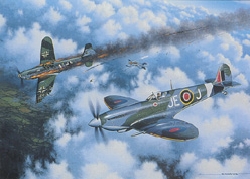|
|
| Canadian Heroes |
|
 |

|
 |
|
|
| DESCRIPTION |
 |
| 16 x 11.5 Inch Collector Size Unframed Lithograph $40.00
James Edgar ("Johnnie") Johnson was the Royal Air Force's top fighter ace in Europe with 38 confirmed victories during the War. Johnson was called up in 1939 following his training with the RAF Volunteer Reserve. Having been hospitalized for much of the Battle of Britain Johnson's first serious action was in mid-1941 when he often flew with Douglas Bader's section. Johnson was promoted quickly and was awarded the Distinguished Flying Cross following his fifth victory in 1941. In early 1943 Johnson was put in command of a wing of the Royal Canadian Air Force. Flying the high-performance Supermarine Spitfire Mark IX Johnson achieved 18 victories in seven months of flying. Many of Johnson's victories were achieved against the Messersmitt Bf-109. Promoted to Group Captain in early 1945 Johnson was put in command of the 125 Wing for the duration of the War. The Supermarine Spitfire is the only Allied fighter to have been continuously produced from before 1939 to after 1945. In total more than 22000 of these splendid aircraft were built. The chief designer of the Spitfire was R.J. Mitchell a brilliant engineer who joined the Supermarine company in 1916 and by 1920 was its chief engineer. Mitchell fashioned a number of high performance maritime aircraft culminating with the sleek "S" series of float planes. This is the float plane which ultimately won permanent possession of the coveted Schneider Trophy for Britain and established a new world speed record in excess of 400 MPH in 1931. In that same year the Air Ministry issued a specification for a new high-performance day/night fighter. Mitchell's design the Type 224 lost out in the competition to the Gloster Gladiator biplane. In 1936 the new Rolls Royce Merlin engine was fitted to a prototype 224 and the Spitfire was born. Achieving a speed of 396 MPH the RAF was impressed and initial orders for the first Spitfires were placed. Sadly R.J. Mitchell succumbed to cancer in 1937 at the age of only 42. With the onset of the War Spitfire production soared and the aircraft was steadily improved. The Mark IX as depicted in Stan Stokes' painting entitled Canadian Heroes first entered service in July 1942. The Mark IX was identifiable because of its four-bladed prop and its twin radiators. Introduced partially in response to Germany's introduction of the Focke Wolfe FW 190 the Mark IX was produced in greater numbers (5665) than any other particular Spitfire model. As depicted in Stoke's painting Johnnie Johnson has just attained another victory over a Bf-109 while flying with the Royal Canadian Air Force in 1944. The painting is dedicated to the many Canadians which served with the RAF during the War |
|


|